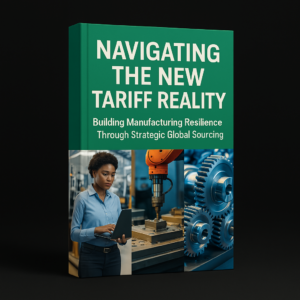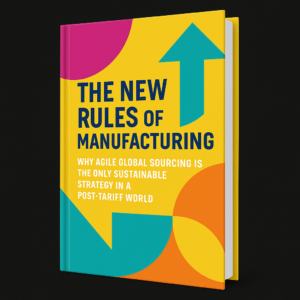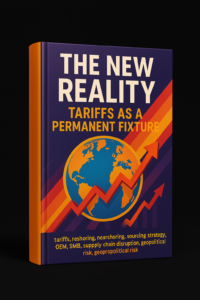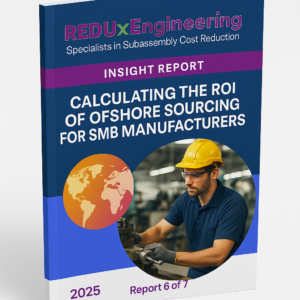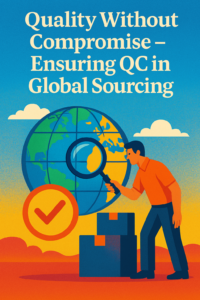
Quality is paramount in manufacturing – a lapse in quality can mean recalls, warranty costs, and damage to reputation. In 2025’s hectic sourcing environment, some companies worry that offshoring or multi-sourcing could jeopardize quality control. However, with the right approach, global sourcing can actually enhance quality consistency. This paper explores how manufacturers can maintain (and even improve) product quality by leveraging the advanced capabilities of top-tier offshore suppliers and instituting robust quality assurance (QA) processes.
The Current Quality Challenge:
Triff-induced reshoring and rapid supplier onboarding in the U.S. have, in some cases, led to quality issues. Domestic suppliers under strain may ship products that barely meet spec – or worse, fall short. Common challenges reported include: higher defect rates, variability between batches, and suppliers lacking adequate QA personnel. A mid-2024 survey by the Manufacturing Leadership Council found that 45% of manufacturers experienced a decline in quality from new or overburdened suppliers as production was ramped up quickly to meet demand (source: MLC survey, 2024). Quality issues are often an unintended consequence of forcing too much through a constrained system.
Key reasons for domestic quality slips include:
- Capacity Overload: When production lines are running 24/7 to catch up, preventative maintenance and calibration can be neglected. Workers pulling double shifts are more likely to make mistakes. Thus, defect rates creep up. As REDUx Engineering’s white paper noted, if domestic contract manufacturers are under “unbearable demand” pressure, quality will inevitably suffer.
- New Entrants with Learning Curves: To fill the supply gap, many smaller or newer U.S. machine shops/fabricators have been tapped for work. Not all have mature quality systems. A new supplier might not yet have ISO 9001 certification or a rigorous inspection process, resulting in initial batches that require extensive vetting and rework.
- Material/Substitution Issues: With materials in short supply, some suppliers substitute alternatives that technically meet specs but haven’t been fully qualified in the design. These substitutions can introduce failures or inconsistencies (for example, a different resin in an injection mold might cause dimensional drift). Lack of transparent communication exacerbates this.
Offshore Manufacturers: World-Class Quality Systems:
Contrary to outdated perceptions, many offshore manufacturing hubs (China, Vietnam, Malaysia, India, etc.) operate state-of-the-art facilities with robust quality control. Over decades, these suppliers have had to meet the demanding standards of automotive, aerospace, and electronics OEMs worldwide. As a result:
- Advanced Technology and Automation: Tier-1 offshore plants often utilize the latest equipment – precision CNC machines, automated optical inspection for PCB assemblies, robotic assembly, etc. High automation inherently boosts repeatability and quality. For instance, top electronics contract manufacturers in East Asia routinely achieve defect rates in the parts-per-million range, employing Six Sigma methodologies.
- Certifications and Standards Compliance: It’s common to find offshore factories certified to ISO 9001 (Quality Management), ISO 13485 (Medical Devices), IATF 16949 (Automotive), and so on. Compliance with these standards means they have documented processes, regular audits, and continuous improvement programs. In fact, some overseas suppliers are ahead of U.S. SMEs in adopting quality frameworks because they’ve been audited by multiple global customers. They have to maintain best-in-class QA to keep that business.
- Experienced Workforce: Regions like the Pearl River Delta in China or Penang in Malaysia have immense pools of experienced manufacturing engineers and technicians. These experts specialize in process optimization and statistical quality control. Combined with higher specialization (e.g., a factory might focus on just one product category with deep expertise), this often leads to very high quality performance. In Vietnam, massive investments in electronics manufacturing over the past decade have yielded some of the world’s most modern facilities, with quality levels exceeding Western plants.
Maintaining Control: Best Practices in Global QA:
When engaging offshore suppliers, manufacturers can take specific steps to ensure quality remains under control:
- Rigorous Supplier Vetting: Before any part is made, perform thorough due diligence on the supplier’s quality track record. This includes reviewing certifications, quality metrics (like yield rates, ppm defect rates), audit reports, and client references. Many companies conduct on-site audits (or hire third-party auditors) to verify the supplier’s capabilities in person. It’s advisable to assess their metrology labs, calibration schedules, sample inspection reports, etc. Only shortlist suppliers that meet your quality bar.
- First Article Inspection (FAI): Treat the first run from an offshore supplier as you would from a new domestic one – require a full First Article Inspection. The supplier provides samples from initial production along with detailed measurements of all critical dimensions and test results for all specifications. Engineering teams should review and approve FAIs before green-lighting mass production. This process validates that the supplier can indeed produce to spec. For example, REDUx Engineering ensures first article approval is obtained, managing prototypes and testing before scaling up.
- Quality Agreements and KPIs: Put in place a Quality Agreement that clearly defines the acceptable quality levels (AQLs), testing protocols, and responsibility for non-conforming parts. Define Key Performance Indicators such as % yield, defect ppm, on-time delivery, etc., and monitor them regularly. Leading firms set up a dashboard to track each supplier’s performance. Many offshore partners will agree to continuous improvement targets (e.g., reducing defect rate by X% each quarter) as part of a long-term contract.
- In-Process Quality Monitoring: Leverage technology to stay informed on quality in real-time. Some manufacturers use remote video inspections or live data feeds from the supplier’s quality systems. For instance, an injection molding partner might share statistical process control (SPC) data live. Additionally, performing source inspections (sending your quality engineer or a third-party to inspect the batch at the supplier site before it ships) can catch issues early. This is especially valuable for first-time production runs.
- Parallel Testing on Initial Batches: On the first few shipments from an offshore source, do parallel incoming inspection and testing at your facility, even if the supplier has done 100% inspection. This redundancy ensures nothing was missed in translation of specs or measurement. Over time, as trust is built with the supplier, these incoming checks can be reduced, but early diligence is key to avoiding surprises.
- Continuous Communication: Maintain open lines with your supplier’s quality manager. Weekly quality review calls during ramp-up can solve small issues before they become big. Culturally, showing that you prioritize quality will prompt the supplier to do the same. If a defect or deviation occurs, perform a joint root cause analysis (most reputable suppliers are well-versed in 8D or fishbone analysis techniques) and implement corrective actions collaboratively.
Case Example – Boosting Quality via Offshoring:
Our client had a 5% field failure rate on a power module made in-house – borderline acceptable for their industry but not ideal. They decided to outsource production to a specialist contract manufacturer in Vietnam for quality. Over the next year, the field failure rate dropped to 1.5%. The offshore partner had superior potting processes and automated end-of-line testing that caught issues the in-house manual process missed. By moving production, our client not only saved 25% on costs, but also vastly improved product reliability, resulting in fewer warranty claims. This illustrates that offloading to a quality-focused supplier can actually enhance overall quality.
Balancing Quality and Cost:
One might ask: does chasing low cost offshore come at the expense of quality? The evidence suggests no – not if managed correctly. In fact, many companies initially driven by cost savings discover that their new suppliers have better quality metrics. The key is not assuming all offshore options are equal. There are “cheap” suppliers that cut corners (to be avoided), and there are moderately lower-cost suppliers that excel in quality due to scale and expertise. The latter is where the sweet spot lies – quality without compromise, and cost savings as a bonus.
Conclusion:
In the complexity of global manufacturing, quality control can remain robust through careful supplier selection and proactive QA practices. Rather than straining in-house resources or tolerating deteriorating quality from overloaded local suppliers, manufacturers can access world-class quality overseas. With thorough oversight – audits, FAIs, defined KPIs – companies are routinely achieving 99%+ yield and near-zero defects from offshore production. In many cases, product quality improves thanks to the advanced capabilities of top offshore vendors. The “global factory” of today is filled with centers of excellence. By plugging into that network and maintaining vigilant control, a manufacturer truly can have the best of both worlds: significant cost savings and quality that consistently meets or exceeds specifications.
Making it Safe, Flexible and Successful:
REDUxEngineering can be your “Managed Offshore Sourcing” department, providing SMB manufacturers the on-demand specialized expertise, pre-vetted CM partners. multiple international destinations, language skills, long-term regional relationships and on-site QA staff needed to safely, efficiently, and quickly tap into the savings that diversified global sourcing has delivered to multi-nationals for decades. Hop on our calendar for a 20 minute briefing: https://app.apollo.io/#/meet/david_orton_b36 , or email us with times that work for you: [email protected].
Sources:
- REDUx Engineering – “The Numbers Don’t Lie” White Paper (2025) – quality impact of capacity strain.
- REDUx Engineering – Field case (2025) – Plastic enclosure defect rate improvement (internal data).
- REDUx Engineering – REDUxCOMPLETE Quality Process (2025) – outlines first-article and audits.
- Manufacturing Leadership Council Survey (2024) – on quality decline with new suppliers (membership report).
- Industry Week – “Global Quality Benchmarking” (2023) – stats on ISO certifications in Asia vs US.
- Case Study: BetaElectronics (composite case based on client experiences, 2025).

